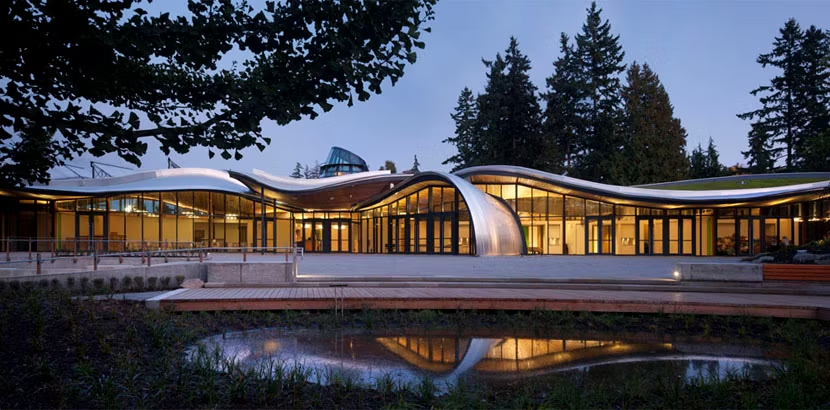Architects: Want to have your project featured? Showcase your work through Architizer and sign up for our inspirational newsletters.
Few places in North America are experiencing rapid growth and a dynamic, emerging design culture like the Pacific Northwest. This region is a hotbed for low-impact, pedestrian-friendly design, with projects that emerge from a common appreciation of craft, materials and natural systems. Situated in a variety of different landscapes including islands, fields and mountains, the best Pacific Northwest architecture engages with the unique challenges and opportunities of its site. As such, these buildings initiate and articulate newfound dialogs between place, space and people.
The first part of this collection showcases eight dynamic residential projects by a variety of different firms across the region. Whether designed as passive structures, powerful datums or playful abodes, each project shows an approach to local architecture and design that’s simultaneously critical and creatively reinterpreted. Context heavily influences each project, carefully exploring the intricate layers of view, access and scale.
The second part of the collection examines landmark designs across various typologies in the public realm. Whether commercial, religious, or educational in nature, each project embodies the dynamic emerging design culture found in this region. Cities like Seattle, Portland, and Vancouver have made great strides in advocating for sustainable and innovative practices, each location promoting new planning and policies to address civic and cultural demands.
Sit back, relax and take in a healthy dose of design inspiration from across the Pacific Northwest:
Private Residential Projects

© Olson Kundig

© Olson Kundig
The Pierre by Olson Kundig Architects, San Juan Island, Wash.
Olson Kundig’s Pierre house was designed as an unexpected retreat securely nestled into a rock. Depending on the angle, the house can seemingly disappear into nature. The rock itself also extends into the house and was used as a concrete aggregate where it was excavated.


San Juan Island Passive by Artisans Group, Shaw Island, Wash.
From its pinwheel design to its floor-to-ceiling glass, the San Juan Island Passive house embodies a sustainable, sleek and energy-efficient architecture. Pre-manufactured walls and a mechanical core combine to create a solid, innovative building. A refuge that’s simultaneously flowing and adaptable, the house was carefully designed to allow long sight-lines and celebrate its unique island site.

© FINNE Architects

© FINNE Architects
Port Ludlow Residence by FINNE Architects, Hood Canal, Wash.
This house on the Hood Canal was created as a simple glazed living space that becomes a front porch to the surrounding wooded waterfront. The main living volume is completely glazed, while the other exterior materials are maintenance-free. Large overhangs, natural lighting and ventilation, as well as two-by-eight wall construction make up some of the sustainable building features in the design.

© Olson Kundig

© Olson Kundig
Rolling Huts by Olson Kundig Architects, Okanogan County, Wash.
Rolling Huts was created as a response to the client’s need to host visiting guests. Deferring to its natural surroundings, each hut is lifted above the meadow on wheels. The low-tech, low-impact designs enjoy views of the mountains while being united by their proximity to one another.

© Patkau Architects

© Patkau Architects
Linear House by Patkau Architects, Salt Spring Island, Canada
One of the primary site features of the Linear House is that it is bisected from east to west by a long row of mature Douglas fir trees. Other sides of the house include a hay field and orchard. The house helps to reinforce the cultural landscape to the south and the natural landscape to the north as well as being able to transform into an open-air pavilion.

© Prentiss + Balance + Wickline Architects

© Prentiss + Balance + Wickline Architects
Cortes by Balance Associates, Cortes Island, Canada
Located on a site formed of natural granite bedrock, the Cortes was designed as an elevated living space overlooking the sea. Steel columns, exposed wood floor beams, and cantilevered decks combine in the raised space, while concrete visually anchors the house to the bedrock.

© Designs Northwest Architects

© Designs Northwest Architects
Lake Union Float Home by Designs Northwest Architects, Seattle
This house is located on Lake Union in Seattle. The structure was created for a retired couple that collects art and enjoys being on the water. The floating house was designed to fit into the wharf buildings along the waterfront.


© Lara Swimmer
Olympia by Coates Design Architects, Yelm, Wash.
Olympia house is an L-shaped structure on a 10-acre parcel of land. Following the main concept of simplicity, the design addresses both aesthetic and budgetary concerns. Sleek, cost-effective materials combined with modest clean lines and minimal color to complete this “livable modern” house.
Public Projects


Seattle Central Library by REX/OMA, Seattle, WA, photographed by James Ewing
Widely recognized as one of the greatest projects in North America, the Seattle Central Library is a celebrated library and civic space. Programming was at the project’s heart, materializing directly into the building form we see today. Robust in both logic and elegance, the library is arranged across five platforms and four flowing planes, each space an information store where all media is presented “equally and legibly.”

© HUSH, Skylab

© HUSH, Skylab
Nike “Camp Victory” by Skylab Architecture and HUSH, Eugene, OR
Located at the Olympic Running Trials in Eugene, OR, Nike’s “Camp Victory” was designed as a physical/digital experience focusing on playful competition. Visual design, information display, and sensory experiences combine to create three unique zones in the project. The immersive areas include a Nike+ HeatMap data visualization space, head-to-head Treadmill Running Game, and an XL Speed Tunnel.


Federal Center South Building 1202 by ZGF Architects LLP, Seattle, WA
Combining a stainless steel façade and salvaged lumber, the new Federal Center South Building 1202 was designed in the shape of an oxbow. A diagrid structure provides flexible workspaces, while the building form provides energy-performance benefits. The building was created to foster community while meeting the US General Services Administration’s (GSA) security requirements.

© Ema Peter Photography

© MGA | MICHAEL GREEN ARCHITECTURE
Wood Innovation and Design Centre by MGA | Michael Green Architecture, Prince George, Canada
A gathering place for design professionals, academics, and researchers, this center helps foster ideas for innovative uses of wood. Programmatically, the building includes educational space and offices for government and wood industry-related organizations. No concrete was used above the ground floor slab, showcasing a simple “dry” timber and glulam structure.

© Perkins&Will

© Perkins&Will
VanDusen Botanical Gardens Visitor Centre by Fast + Epp, Vancouver, Canada
This visitor center in Vancouver was created as a welcome portal and interactive education center with a dramatic free-form roof flowing into the surrounding landscape. The design aimed to revitalize public interest in the botanical gardens while including space for exhibitions, lectures, guest services, and a café. The building was designed to target LEED Platinum status and the Living Building Challenge.

© ZGF Architects

© ZGF Architects
King Street Station by ZGF Architects LLP, Seattle, WA
First opened in 1906, King Street Station underwent a new rehabilitation under ZGF Architects to restore and preserve the station’s original character. The project aimed to strengthen King Street Station’s role as an important civic landmark and modern transportation hub. Becoming a catalyst for neighborhood redevelopment, the project improved multi-model connections, enhanced public space, and achieved LEED Platinum certification.

© Jeremy Bittermann

© Skylab
Columbia Building by Skylab Architecture, Portland, OR
Portland’s new Wastewater Treatment Plant Engineering Building was created to foster collaboration, achieve LEED Gold, and return storm water to the Columbia Slough. A folded saw-tooth roof drains roof runoff into a berm and bioswale. The building’s entrance was modified to provide an adaptive and native environment, while a public space was also created with views to a nearby pond.

© Ben Benschneider

© benjamin benschneider
Seattle Art Museum: Olympic Sculpture Park by WEISS / MANFREDI, Seattle, WA
Located on the water’s edge, this Seattle park was designed as a new model for urban sculpture parks. A continuous constructed landscape was created, one that descends 40 feet from the city streets to the waterfront. An uninterrupted z-shaped “green” was formed that rises above existing infrastructure below.


Chapel of St. Ignatius by Steven Holl Architects, Seattle, WA
The Chapel of St. Ignatius was created as a Jesuit worship space at Seattle University. Conceptually, seven bottles of light are held together within a stone box, each containing a colored lens and a unique reflected color. The volumes correspond to the different parts of Jesuit Catholic worship.

© benjamin benschneider

© Nic Lehoux
Bullitt Center by The Miller Hull Partnership, Seattle, WA
The Bullitt Center is the first leasable market rate commercial structure to target requirements for the Living Building Challenge. A landmark building in Seattle, the design was created to inform future high-performance urban buildings. Designed to achieve net-zero energy use with 100% on-site renewable energy, the center gained attention for its potentially illegal systems. As mentioned in one of our previous articles, in Washington, it’s illegal to take rain water and filter it for drinking. The Bullitt Center was designed to use its treated rainwater for graywater until future changes to the law.
Architects: Want to have your project featured? Showcase your work through Architizer and sign up for our inspirational newsletters.









